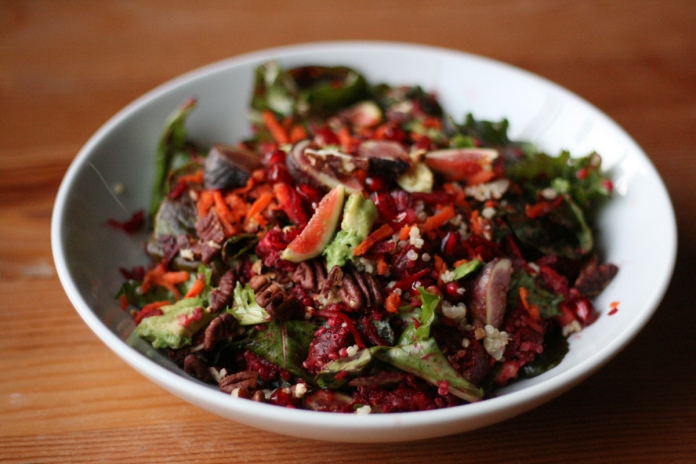Here is a seasonal recipe combining the last of the summer fruit season with the beginning of the winter one. I really like the sweetness the ripe figs add to this salad but if you’re unlucky enough to live in a place where figs are no longer available, you can add some fig jam to the dressing or just skip the figs altogether.
The main sources of protein in this salad are the quinoa and pecans. I try to time it so that both the quinoa and the pecans are still warm by the time they go in the salad. We prep the fruit and vegetables while the quinoa is on the stove, the pecans go in to the oven just before the quinoa is ready to rest and we toss and dress the salad as the pecans cool.
Baby kale autumn salad with figs and pomegranate
Inspired by Maria Matyiku’s ‘Salată de smochine cu brânză de capră şi rucola‘ recipe on The Epoch Times Romania
Serves 2
Ingredients
-
Quinoa
- 1/3 cup dry quinoa (yields 1 cup cooked quinoa)
- 1/2 cup water
-
Pecans
- 1/2 cup pecans
-
Salad
- 3.5 oz (100 g) baby kale or your favorite salad greens, rinsed and dried
- 1 avocado, cubed or sliced
- 1 carrot, grated
- 1 beet, peeled and grated
- 4 fresh figs, stems removed and cut into eight pieces
-
Dressing
- 2 tablespoons sunflower or olive oil
- 1 1/2 teaspoons balsamic vinegar
- 1 teaspoon freshly squeezed lemon juice
-
Toppings
- 1/4 cup pomegranate seeds
Directions
-
Preheat oven
Preheat the oven to 350° F.
-
Cook quinoa
Sort and rinse the quinoa in a fine-mesh strainer. Bring the quinoa and water to a boil, then cover and reduce the heat to a simmer. Cook covered for 15 minutes. Remove the quinoa from the heat and let it sit, still covered, for 10 minutes. Fluff with a fork.
-
Toast pecans
Once the oven is preheated, toast the pecans for about 7 minutes. Once toasted, transfer to a dry cutting board to cool. Once cool enough to touch, chop them into whatever size chunks you like.
-
Prepare salad
Meanwhile, place baby kale or salad greens in a large bowl. Toss in the cubed or sliced avocado, grated carrot and beet, and figs.
-
Dress salad
While waiting for the pecans to finish toasting, you can dress the salad. We generally don’t mix the dressing separately but rather add in sunflower oil, balsamic vinegar, and lemon juice to taste. You may want to use more or less of each of the dressing ingredients, depending on how potent yours are on their own and which taste you prefer to shine through the most.
-
Plate salad and add toppings
As the pecans are cooling, plate the salad. Sprinkle each plate with 1/4 cup to 1/2 cup of quinoa. Toss the salad if you’d like it to be evenly distributed. Sprinkle each plate with half of the pomegranate seeds and half of the chopped pecans. Serve immediately.
Tips
Sources of sodium
- Very small amounts naturally occur in kale, avocado, and quinoa
Modifications
-
Make it vegetarian
Cooking grains
We don’t have a small saucepan with a lid that creates a perfect seal. This results in us almost always burning grains when we use only the amount of water recommended. We always add a little bit more and then drain any remaining liquid after the resting period.
Notes on ingredients
-
Carrots
We always buy organic carrots because they taste sweeter than non-organic carrots. If you don’t use organic carrots, I would recommend peeling them before grating them.
-
Figs
Figs don’t last very long, so make sure to taste them before adding them to the salad. If they’re past their prime, they might detract from — rather than add to — the rest of the salad. I unfortunately made this mistake the second time I made it.
-
Kale
We prefer baby kale to regular kale mostly because it is so much easier. Picky eater over here only likes regular kale when it’s chopped into very small pieces and then massaged — yes, that’s right, massaged — with the dressing. And if it’s not massaged until it really softens, I will pout all through dinnertime. It’s generally not worth the effort or the chapped hands that result from it to use regular kale.
-
Pomegranate seeds
There are several ways to get pomegranate seeds out without having to pluck them out individually. I seed my pomegranates using the underwater method. Cut off the top and bottom and score the skin deeply enough that it will be easy to break the pomegranate into quarters or sixths, but not deeply enough to cut through the skin and into the seeds and make a mess. In a medium bowl filled with water, break apart the pomegranate and run your fingers over the seeds to remove them. Most of the membrane will float to the top of the water and can be easily pulled out with the skin. Drain the seeds and try not to eat them all before everything else is ready.
There’s also a spoon whacking method that I’ve never tried, but here’s a random YouTube video demonstrating how to do it.
Did you make this?
- If you recreate this recipe, I’d love to know! Leave a comment here and tag @alickofsalt on social media.


